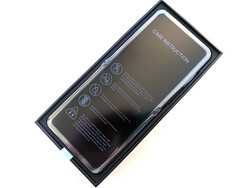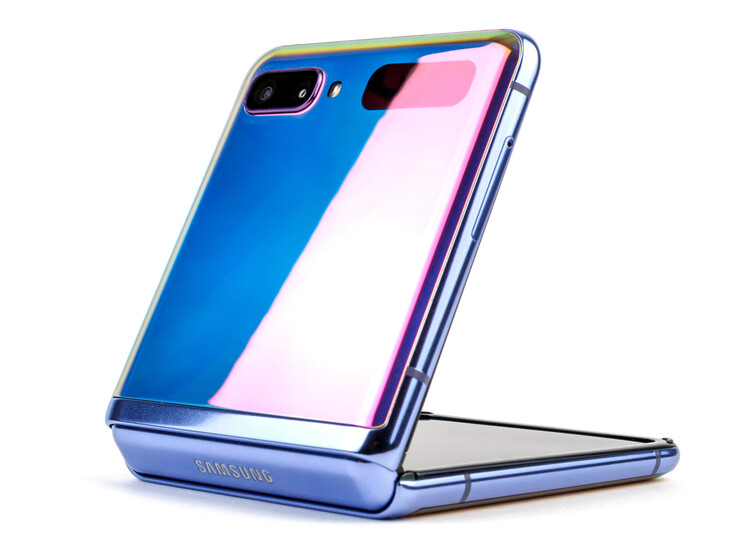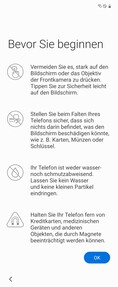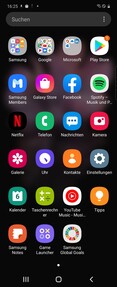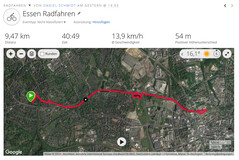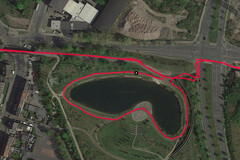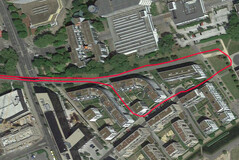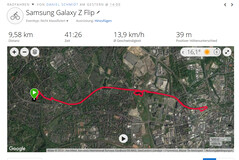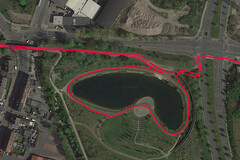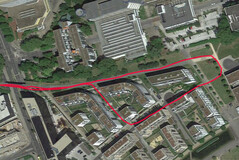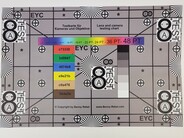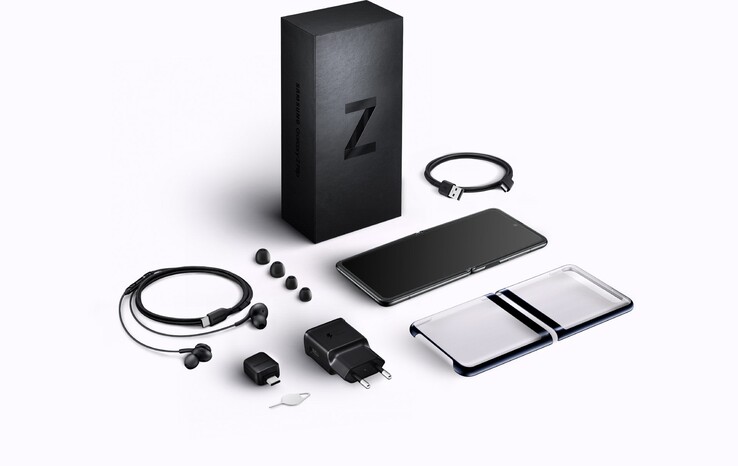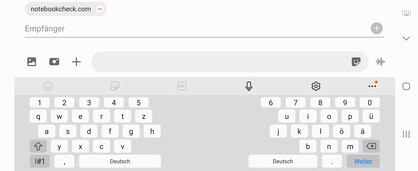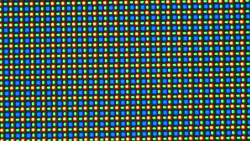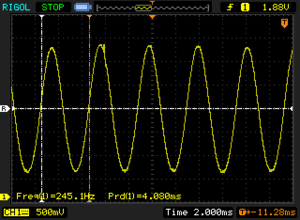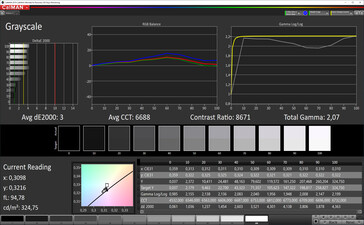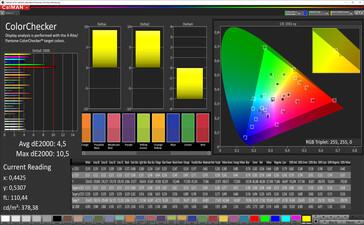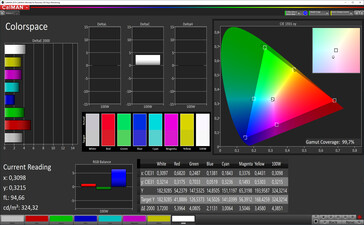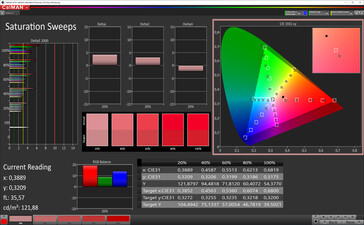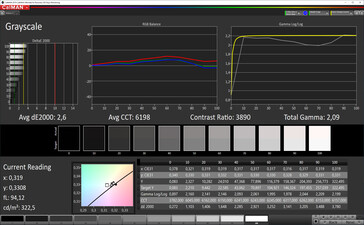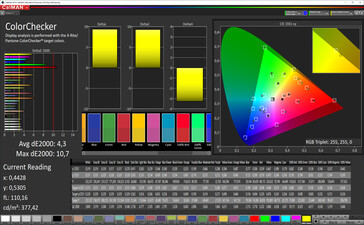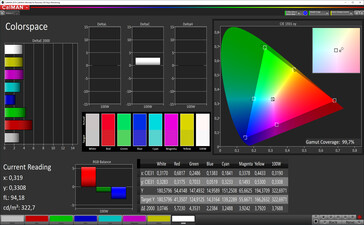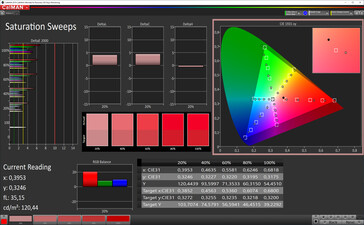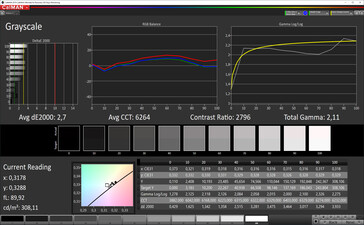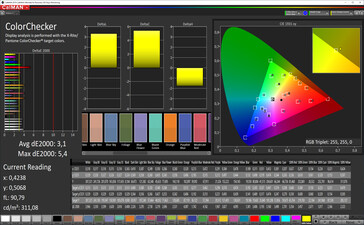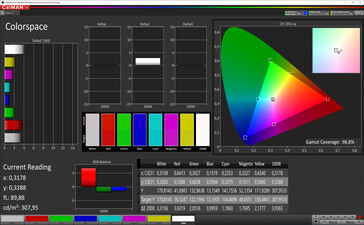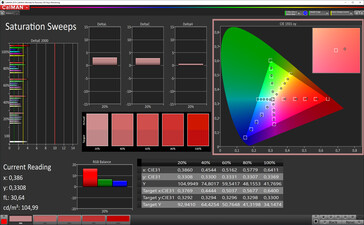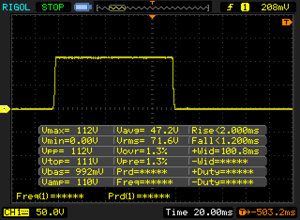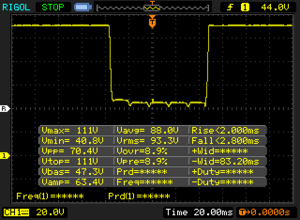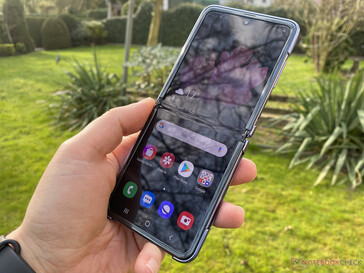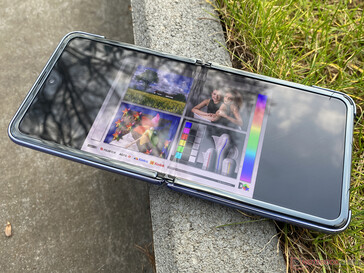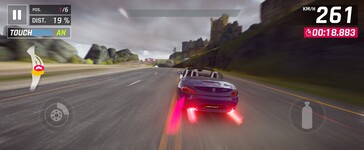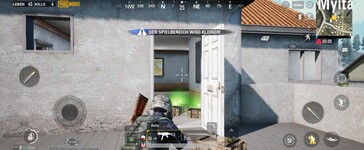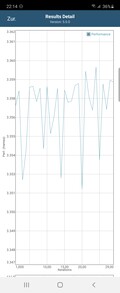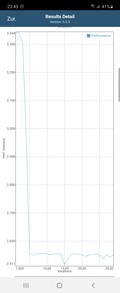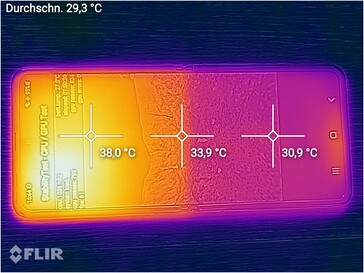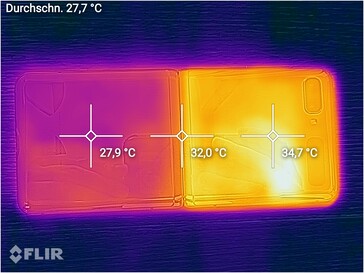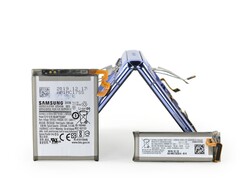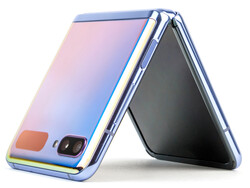Samsung Galaxy Z Flip review - The better foldable smartphone
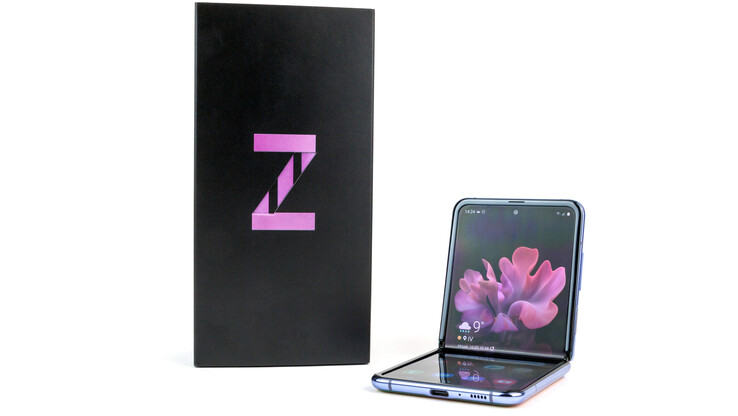
After the Galaxy Fold comes the Galaxy Z Flip, which is not to be understood as a successor but as an independent series offering an alternative display concept. In doing so, and similar to the Motorola Razr, the phone unfolds into a large smartphone display, while the panel is well protected when folded.
This makes the Galaxy Z Flip a bit thicker but also significantly more compact. The hardware configuration is, unlike with the smartphone of the Lenovo subsidiary, not on the mid-range level but is oriented towards the high-end models of 2019. At 1,480 Euros (~$1,593), the Flip is anything but a bargain and is similarly expensive as the current top-of-the-line model of the Galaxy S20 series. However, it is strongly inferior to the latter according to the data sheet, even if the review shows that this isn't really the case in all respects.
Comparison devices
Rating | Date | Model | Weight | Drive | Size | Resolution | Price |
|---|---|---|---|---|---|---|---|
| 82.5 % v7 (old) | 03 / 2020 | Samsung Galaxy Z Flip SD 855+, Adreno 640 | 183 g | 256 GB UFS 3.0 Flash | 6.70" | 2636x1080 | |
| 86.9 % v7 (old) | 11 / 2019 | OnePlus 7T Pro SD 855+, Adreno 640 | 206 g | 256 GB UFS 3.0 Flash | 6.67" | 3120x1440 | |
| 87.4 % v7 (old) | 07 / 2019 | Samsung Galaxy S10 5G Exynos 9820, Mali-G76 MP12 | 198 g | 256 GB UFS 2.1 Flash | 6.70" | 3040x1440 | |
| 86.4 % v7 (old) | 10 / 2019 | Samsung Galaxy Fold SD 855, Adreno 640 | 276 g | 512 GB UFS 3.0 Flash | 7.30" | 2152x1536 | |
| 89 % v7 (old) | 12 / 2019 | Huawei Mate 30 Pro Kirin 990, Mali-G76 MP16 | 198 g | 256 GB UFS 3.0 Flash | 6.53" | 2400x1176 |
Case - Glass in the display of the Galaxy Z Flip
The Samsung Galaxy Z Flip is available in black and purple and has a glossy metal frame. The glass on the back is made of Corning Gorilla Glass 6, and the cameras are protected by Gorilla Glass 3. The camera module is not particularly tall and protrudes 0.7 millimeters from the case. When folded, the Flip measures a compact 87.4 x 73.6 x 17.3 millimeters (~3.4 x 2.9 x 0.68 inches).
The new two-axis hinge of the foldable Galaxy smartphone plays an important role. This should be able to be used 200,000 times without loss of quality. In addition, the FreeStop fibers within the mechanics protect the interior of the smartphone from dust. As our colleagues from iFixit show, this only helps to a limited extent against vast amounts of dust, but it should be noted at this point that the Flip doesn't feature an IP certification against the penetration of dust or water. We had no problems with it in everyday use, but if you carry the Galaxy Phone around in your pocket, you'll have to clean the crease of the panel from dust and lint more often; these collect there due to the components not being flush with each other.
The workmanship of the Galaxy Flip is really good. It's nice that Samsung has now applied a razor-thin glass composite layer over the panel to protect it, but there is still a protective film on top of it, which is very susceptible to fingerprints and difficult to clean. The warning to handle the Galaxy Z Flip with care remains as well. Owners are welcomed by these warnings as soon as they unpack the smartphone.
Connectivity - Shortcomings despite high price
In comparison to the top models, which are sometimes also significantly cheaper, users of the Galaxy Z Flip have to make some compromises. In this way, there is only one USB 2.0 port that supports PD and OTG but no wired image output. The Flip can't use Samsung's DeX.
There are also limitations in terms of the communication modules, since there's no Wi-Fi 6 and a 5G version isn't available either. The Samsung phone has a nano SIM slot and supports an additional eSIM. There is no possibility to expand storage via a microSD card.
Neither is a radio receiver or an audio jack integrated. Wired sound output is done over USB-C.
When folded, the Galaxy Z Flip measures 87.4 x 73.6 x 17.3 mm (length x width x height).
Software - Galaxy Smartphone with Android 10
The Galaxy Z Flip comes with Android 10 and One UI 2.1. At the time of conducting this review, the security patches are at the level of February 1, 2020 and are therefore quite up-to-date.
As with their other smartphones, the Koreans have preinstalled a number of apps, including their own app store. The former can't all be completely uninstalled but only deactivated. A nice feature for Spotify users is that any song can be used as an alarm clock sound.
Communication and GNSS - Wi-Fi 5 with room for improvement
The Galaxy Z Flip reaches the mobile Internet via LTE at best, but contrary to what the modern SoC suggests, there is no 2 Gbit speed but a slightly throttled version with LTE Cat. 16. The range of supported frequencies is widely spread, so that connecting to mobile networks should be possible across the globe.
On home WLAN, the smartphone connects at best with Wi-Fi 5 (IEEE 802.11 a/b/g/n/ac, MIMO, VHT80), which means that both 2.4 and 5.0 GHz networks can be used. In everyday use, the Flip delivers good performance, but in tests with our reference router, the Netgear Nighthawk AX12, the smartphone shows a performance that falls short of expectations when sending data. However, this is only noticeable in everyday usage when sending larger amounts of data.
The location determination with the Galaxy Z Flip will not work inside buildings, although the signal strength is actually high enough. Outdoors, however, this is achieved quite fast, and the location quickly settles to an accuracy between 3 and 4 meters (~10 and 13 feet).
On a short bike ride, the foldable smartphone has to face the comparison with the Garmin Edge 500 bike computer. For a total distance of over 9 kilometers (~5.6 miles), the difference between the two devices is of at least 110 meters (~120 yards). In reality, however, the difference is in favor of the Flip, which records the route a little more precisely.
Telephone and call quality
Samsung hasn't changed anything obvious about the telephone app in One UI 2.1. Features like Wi-Fi calling or hearing aid compatibility are also configured there. VoLTE is supported.
The call quality is mixed. When held to the ear, the user of a Galaxy Z Flip sounds a bit dull and nasal. The speaker can only be used in quiet environments, and even then, it shouldn't be too far away from the speaker, since voice reception may be interrupted otherwise. In the test, a distance of less than an arm's length was already enough to cause this.
Cameras - AR stickers with advertising
The Samsung Galaxy Z Flip's front-facing camera is reminiscent of that of the Galaxy S10 and offers 10 MP with autofocus and numerous other features. The quality of the front-facing camera is quite good, but it fades noticeably in low ambient light. Those who like to use AR stickers will be in for an interesting surprise, since these now include advertising. The photo can be taken normally, but if a fashionable accessory is selected, the smartphone will show the matching original product after the photo is shot, including the price and link to the shop - very business-minded.
The main camera can also be used for selfies without any problems. For this, the smartphone has to be folded and the power button needs to be pressed twice to activate the camera. The small external display serves as a viewfinder, which only shows a part of the image section but is sufficient for orientation. It's also practical that both hand gestures and the volume rocker can be used as a shutter release.
The main camera offers an additional ultra wide-angle lens alongside a traditional wide-angle one. Up to an 8x zoom is digitally possible, but it's not quite convincing. The setup is reminiscent of the S10e, and the image quality is on this level too - definitely a good camera but not the best.
Videos are recorded at best in Ultra HD at 60 FPS on both sides. If you also want to record in HDR10+, you have to limit yourself to 30 FPS. We like the videos, and they have both good image stabilization and sharpness, but the color reproduction could be more accurate. The two-channel sound is very good; it's extremely low-noise and clear.
Photos taken from the same position (starting left): Ultra wide angle, wide angle, 8x zoom
Under controlled lighting conditions, we subject the camera to further tests. In our test chart, the image sharpness in the middle is in order, but we can't detect a typical oversharpening. There's only a slight blur around the edges.
Colors are displayed a bit too brightly for the most part, and greens lack a bit of intensity, but overall, the image quality is on a very decent level.
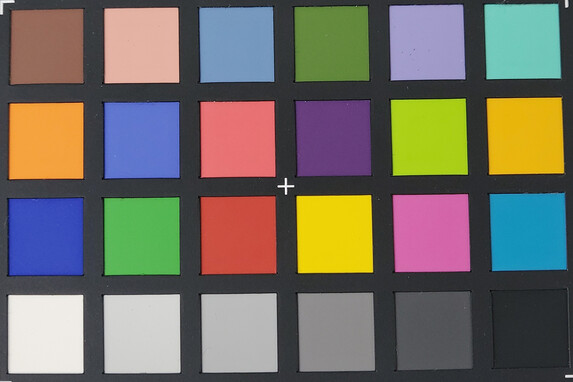

Accessories and warranty
In the box, the Samsung Galaxy Z Flip comes with a modular power adapter (9 V - 1.67 A; 5.0 V - 2.0 A), a USB cable (Type-A to Type-C), a SIM tool, an OTG adapter, a USB headset and a clear, two-piece protective case. A thicker leather case is optionally available in the Samsung shop.
Those who register the foldable smartphone with Samsung within 30 days will receive the Care+ insurance package for one year free of charge. This covers one claim within the insurance period with a deductible of 109 Euros (~$117). Liquid damage or a broken display are also covered. The Koreans don't offer an optional Care+ package with a longer term.
Input devices and handling- Fingerprint scanner in power button
The capacitive touch screen of the foldable Galaxy phone recognizes up to ten touches simultaneously and reacts quickly and reliably to input. The sliding properties of the surface are okay, but they aren't comparable with a coated glass surface. In addition, the crease always remains quite visible and tangible.
The biometric security of the smartphone is provided through a fingerprint scanner as well as through 2D face recognition. The former is also the power button and provides a reliable recognition rate with fast unlock times. Face recognition also works very well but is less secure.
Not only does the small external display provide general information such as the date, time and battery status as well as a viewfinder for the camera, but it can also display notifications and be used to control the music player.
The multitasking function can display two apps side by side in split-screen mode or run an app in a draggable window.
Display - Bright Dynamic AMOLED with HDR10+ in the Z Flip
The foldable main display measures a generous 6.7 inches and has a resolution of 2636x1080 pixels. In contrast to the Galaxy Fold, the user doesn't have to make do with a slimmed-down version in terms of brightness, since the panel shines just as brightly as its current sibling models without a foldable display. Expressed in bare figures, this means that it shines at an average of 709 cd/m². With an even distribution of light and dark areas (APL50), it reaches 935 cd/m² at the center of the display, but with increasing contrast (APL25: 984 cd/m², APL10: 999 cd/m²), it is only slightly more. Those who switch off the ambient light sensor have to be content with 329 cd/m².
Due to the OLED technology, absolute blacks can be displayed, which is why the calculation of the contrast ratio tends towards infinity. Also typical for this type of panel is the brightness control by pulse width modulation, which varies between 238.8 and 245.1 Hz with the Galaxy Z Flip.
Features like an always-on display or a night mode are available and can be adjusted by the user to his own needs. While the large main display is normally controlled by the ambient light sensor, this needs to be done manually for the cover display. Unfortunately, we can't measure this 1.1-inch Super AMOLED display. In everyday life, however, it's usually bright enough outdoors to be able to read all the content on it. In summer, however, the viewfinder function might be of limited use.
| |||||||||||||||||||||||||
Brightness Distribution: 97 %
Center on Battery: 705 cd/m²
Contrast: ∞:1 (Black: 0 cd/m²)
ΔE ColorChecker Calman: 3.1 | ∀{0.5-29.43 Ø4.77}
ΔE Greyscale Calman: 2.7 | ∀{0.09-98 Ø5}
98.8% sRGB (Calman 2D)
Gamma: 2.11
CCT: 6264 K
| Samsung Galaxy Z Flip Dynamic AMOLED, 2636x1080, 6.7" | OnePlus 7T Pro AMOLED, 3120x1440, 6.7" | Samsung Galaxy S10 5G OLED, 3040x1440, 6.7" | Samsung Galaxy Fold Infinity Flex-Display (Dynamic AMOLED, 7,3") und Super AMOLED (4,6"), 2152x1536, 7.3" | Huawei Mate 30 Pro OLED, 2400x1176, 6.5" | |
|---|---|---|---|---|---|
| Screen | -3% | -13% | 9% | -2% | |
| Brightness middle (cd/m²) | 705 | 606 -14% | 735 4% | 531 -25% | 592 -16% |
| Brightness (cd/m²) | 709 | 611 -14% | 735 4% | 532 -25% | 605 -15% |
| Brightness Distribution (%) | 97 | 95 -2% | 94 -3% | 97 0% | 96 -1% |
| Black Level * (cd/m²) | |||||
| Colorchecker dE 2000 * | 3.1 | 3.46 -12% | 3.9 -26% | 2.3 26% | 2.5 19% |
| Colorchecker dE 2000 max. * | 5.4 | 5.64 -4% | 10.9 -102% | 3.7 31% | 5.5 -2% |
| Greyscale dE 2000 * | 2.7 | 2 26% | 1.4 48% | 1.5 44% | 2.6 4% |
| Gamma | 2.11 104% | 2.258 97% | 2.09 105% | 2.15 102% | 2.16 102% |
| CCT | 6264 104% | 6779 96% | 6549 99% | 6631 98% | 6173 105% |
* ... smaller is better
Screen Flickering / PWM (Pulse-Width Modulation)
| Screen flickering / PWM detected | 245.1 Hz | ≤ 99 % brightness setting | |
The display backlight flickers at 245.1 Hz (worst case, e.g., utilizing PWM) Flickering detected at a brightness setting of 99 % and below. There should be no flickering or PWM above this brightness setting. The frequency of 245.1 Hz is relatively low, so sensitive users will likely notice flickering and experience eyestrain at the stated brightness setting and below. In comparison: 53 % of all tested devices do not use PWM to dim the display. If PWM was detected, an average of 8084 (minimum: 5 - maximum: 343500) Hz was measured. | |||
We check the color reproduction with the CalMAN analysis software and a spectrophotometer. The Galaxy Z Flip offers the Natural and Vivid color profiles, the latter of which is preset. This uses the larger DCI-P3 color space and offers a slightly cooler calibrated display but can also be adjusted to the user's taste, which doesn't lead to a more natural color reproduction though. The Natural mode, which uses the sRGB color space, doesn't always offer the best average values in terms of DeltaE, but it doesn't show outliers as large as with the preset profile. Both settings provide good color reproduction.
Display Response Times
| ↔ Response Time Black to White | ||
|---|---|---|
| 3.6 ms ... rise ↗ and fall ↘ combined | ↗ 2 ms rise | |
| ↘ 1.2 ms fall | ||
| The screen shows very fast response rates in our tests and should be very well suited for fast-paced gaming. In comparison, all tested devices range from 0.1 (minimum) to 240 (maximum) ms. » 14 % of all devices are better. This means that the measured response time is better than the average of all tested devices (20.2 ms). | ||
| ↔ Response Time 50% Grey to 80% Grey | ||
| 4.8 ms ... rise ↗ and fall ↘ combined | ↗ 2 ms rise | |
| ↘ 2.8 ms fall | ||
| The screen shows very fast response rates in our tests and should be very well suited for fast-paced gaming. In comparison, all tested devices range from 0.165 (minimum) to 636 (maximum) ms. » 15 % of all devices are better. This means that the measured response time is better than the average of all tested devices (31.6 ms). | ||
Outdoors, the Samsung Galaxy Z Flip is always easy to read, which is mainly due to its high brightness. The reflections are kept within limits but aren't quite as low as in the sibling models with anti-reflective glass. In addition, we also perceive that fingerprints are more present on the plastic surface.
Performance - Strong in all areas
With the Snapdragon 855 Plus, a high-end SoC from last year is running in the Galaxy Z Flip, which is supported by a generous 8 GB of RAM. Accordingly, the foldable Samsung mobile phone shows good system performance in everyday use and also masters stutter-free multitasking.
However, the benchmarks show that the SoC lags somewhat behind comparable products, but this shouldn't be noticeable in everyday use.
| AnTuTu v8 - Total Score (sort by value) | |
| Samsung Galaxy Z Flip | |
| OnePlus 7T Pro | |
| Huawei Mate 30 Pro | |
| Average Qualcomm Snapdragon 855+ / 855 Plus (462125 - 501784, n=4) | |
| Basemark GPU 1.1 | |
| 1920x1080 Vulkan Medium Offscreen (sort by value) | |
| OnePlus 7T Pro | |
| Huawei Mate 30 Pro | |
| Average Qualcomm Snapdragon 855+ / 855 Plus (38.9 - 44.6, n=2) | |
| Vulkan Medium Native (sort by value) | |
| OnePlus 7T Pro | |
| Huawei Mate 30 Pro | |
| Average Qualcomm Snapdragon 855+ / 855 Plus (28.5 - 35, n=2) | |
| 1920x1080 OpenGL Medium Offscreen (sort by value) | |
| OnePlus 7T Pro | |
| Huawei Mate 30 Pro | |
| Average Qualcomm Snapdragon 855+ / 855 Plus (42.2 - 45.3, n=2) | |
| VRMark - Amber Room (sort by value) | |
| OnePlus 7T Pro | |
| Huawei Mate 30 Pro | |
| Average Qualcomm Snapdragon 855+ / 855 Plus (4986 - 5025, n=2) | |
Surfing the web is no problem with the Galaxy Z Flip. The values in the benchmarks are normal, but, as expected, not the best.
| Jetstream 2 - 2.0 Total Score | |
| Average of class Smartphone (23.8 - 387, n=149, last 2 years) | |
| Huawei Mate 30 Pro (Chrome 78) | |
| Average Qualcomm Snapdragon 855+ / 855 Plus (62.4 - 70.9, n=5) | |
| Samsung Galaxy Z Flip (Chrome 80) | |
| OnePlus 7T Pro (Chrome 78) | |
| Samsung Galaxy Fold (Samung Browser 10.1) | |
| Samsung Galaxy S10 5G (Samung Browser 9.2) | |
| JetStream 1.1 - Total Score | |
| Average Qualcomm Snapdragon 855+ / 855 Plus (113.9 - 120.8, n=5) | |
| Huawei Mate 30 Pro (Chrome 78) | |
| OnePlus 7T Pro (Chrome 78) | |
| Samsung Galaxy Z Flip (Chrome 80) | |
| Samsung Galaxy Fold (Samsung Browser 10.1) | |
| Samsung Galaxy S10 5G (Samsung Browser 9.2) | |
| Speedometer 2.0 - Result 2.0 | |
| Average of class Smartphone (15.2 - 643, n=121, last 2 years) | |
| Huawei Mate 30 Pro (Chrome 78) | |
| OnePlus 7T Pro (Chome 78) | |
| Samsung Galaxy Z Flip (Chrome 80) | |
| Samsung Galaxy Fold (Samsung Browser 10.1) | |
| Average Qualcomm Snapdragon 855+ / 855 Plus (39.1 - 69.1, n=4) | |
| Samsung Galaxy S10 5G (Samsung Browser 9.2) | |
| WebXPRT 3 - Overall | |
| Average of class Smartphone (38 - 380, n=31, last 2 years) | |
| Samsung Galaxy Fold (Samsung Browser 10.1) | |
| Huawei Mate 30 Pro (Chrome 78) | |
| Samsung Galaxy S10 5G | |
| Average Qualcomm Snapdragon 855+ / 855 Plus (89 - 111, n=5) | |
| Samsung Galaxy Z Flip (Chrome 80) | |
| OnePlus 7T Pro (Chrome 78) | |
| Octane V2 - Total Score | |
| Average of class Smartphone (2228 - 126661, n=196, last 2 years) | |
| Average Qualcomm Snapdragon 855+ / 855 Plus (23781 - 25353, n=5) | |
| Samsung Galaxy Fold (Samsung Browser 10.1) | |
| OnePlus 7T Pro (Chrome 78) | |
| Samsung Galaxy Z Flip (Chrome 80) | |
| Huawei Mate 30 Pro (Chrome 78) | |
| Samsung Galaxy S10 5G (Samsung Browser 9.2) | |
| Mozilla Kraken 1.1 - Total | |
| OnePlus 7T Pro (Chrome 78) | |
| Samsung Galaxy Z Flip (Chrome 80) | |
| Average Qualcomm Snapdragon 855+ / 855 Plus (2007 - 2134, n=5) | |
| Samsung Galaxy Fold (Samsung Browser 10.1) | |
| Huawei Mate 30 Pro (Chrome 78) | |
| Samsung Galaxy S10 5G (Samsung Browser 9.2) | |
| Average of class Smartphone (257 - 28190, n=156, last 2 years) | |
* ... smaller is better
The Galaxy Z Flip's 256 GB of UFS 3.0 storage still leaves room for 223 GB of your own data after first powering the smartphone on. A storage expansion using a microSD card is not possible.
The benchmarks present the storage in the best light, and it consistently delivers very high speeds.
| Samsung Galaxy Z Flip | OnePlus 7T Pro | Samsung Galaxy S10 5G | Samsung Galaxy Fold | Huawei Mate 30 Pro | Average 256 GB UFS 3.0 Flash | Average of class Smartphone | |
|---|---|---|---|---|---|---|---|
| AndroBench 3-5 | -29% | -53% | -33% | 11% | 5% | 110% | |
| Sequential Read 256KB (MB/s) | 1443 | 1489 3% | 816 -43% | 1303 -10% | 1781 23% | 1547 ? 7% | 2252 ? 56% |
| Sequential Write 256KB (MB/s) | 523 | 405 -23% | 246.3 -53% | 394.5 -25% | 401.8 -23% | 575 ? 10% | 1878 ? 259% |
| Random Read 4KB (MB/s) | 184.5 | 169 -8% | 135 -27% | 158.4 -14% | 226.4 23% | 210 ? 14% | 298 ? 62% |
| Random Write 4KB (MB/s) | 212.9 | 26 -88% | 23.79 -89% | 34.41 -84% | 259.2 22% | 188.5 ? -11% | 343 ? 61% |
Games - Performance isn't an issue
We check the gaming suitability with GameBench. The Samsung Galaxy Z Flip shows good frame rates even in demanding games, and the extended screen is especially noticeable in PUBG Mobile, since the controls are moved closer to the edge, making the visibility field broader. However, using the display surface is exhausting as it offers a comparatively high sliding resistance so that fingers become tired faster.
The speaker is also quickly covered by the hand when the smartphone is held in landscape mode.
Emissions - Listen together with Music Share
Temperature
The Galaxy Z Flip's surface temperatures remain very low in idle usage, and under load, the smartphone reaches a maximum of 38.8 °C (~102 °F) in some places, which is absolutely harmless.
We check the SoC's behavior under prolonged load with the GFXBench battery test. The respective benchmark is executed 30 times in a row, and both the battery status and the frame rates are logged. While the older T-Rex test doesn't present the Z Flip with any major challenges, the Samsung mobile phone quickly shows a performance drop of around a third in the more demanding Manhattan scenario, which can certainly explain the lower results in the benchmarks.
(+) The maximum temperature on the upper side is 38.8 °C / 102 F, compared to the average of 35.2 °C / 95 F, ranging from 21.9 to 247 °C for the class Smartphone.
(+) The bottom heats up to a maximum of 35.8 °C / 96 F, compared to the average of 34 °C / 93 F
(+) In idle usage, the average temperature for the upper side is 27.4 °C / 81 F, compared to the device average of 32.9 °C / 91 F.
Speaker
The Galaxy Z Flip's speaker, which is located at the bottom, provides good sound at medium volume and should be perfectly adequate for most everyday reproductions. However, if you turn it up to full volume, you'll notice that it turns into a blaring machine that distorts sound; high tones and head voices in particular can sound unpleasant.
Alternatively, USB-C and Bluetooth are available for sound output. The latter does not support aptX HD. Dual audio is now hidden in the system and is activated when more than one speaker or pair of headphones are connected and is now called "listen together". In addition, there is now a Music Share function, which turns the Z Flip into a Bluetooth hub that can share the connected speakers with other devices without the need to pair them. However, this only works on Samsung smartphones with One UI 2.1 or higher.
Samsung Galaxy Z Flip audio analysis
(+) | speakers can play relatively loud (86.4 dB)
Bass 100 - 315 Hz
(-) | nearly no bass - on average 26.7% lower than median
(±) | linearity of bass is average (11.3% delta to prev. frequency)
Mids 400 - 2000 Hz
(+) | balanced mids - only 4.4% away from median
(+) | mids are linear (3.9% delta to prev. frequency)
Highs 2 - 16 kHz
(±) | higher highs - on average 6.6% higher than median
(+) | highs are linear (3.2% delta to prev. frequency)
Overall 100 - 16.000 Hz
(±) | linearity of overall sound is average (20.1% difference to median)
Compared to same class
» 33% of all tested devices in this class were better, 9% similar, 59% worse
» The best had a delta of 11%, average was 35%, worst was 134%
Compared to all devices tested
» 51% of all tested devices were better, 8% similar, 41% worse
» The best had a delta of 4%, average was 24%, worst was 134%
OnePlus 7T Pro audio analysis
(±) | speaker loudness is average but good (81.4 dB)
Bass 100 - 315 Hz
(-) | nearly no bass - on average 64.7% lower than median
(+) | bass is linear (0% delta to prev. frequency)
Mids 400 - 2000 Hz
(-) | nearly no mids - on average 64.7% lower than median
(+) | mids are linear (0% delta to prev. frequency)
Highs 2 - 16 kHz
(-) | nearly no highs - on average 64.7% lower than median
(+) | highs are linear (0% delta to prev. frequency)
Overall 100 - 16.000 Hz
(-) | overall sound is not linear (120% difference to median)
Compared to same class
» 89% of all tested devices in this class were better, 9% similar, 3% worse
» The best had a delta of 11%, average was 35%, worst was 134%
Compared to all devices tested
» 97% of all tested devices were better, 3% similar, 1% worse
» The best had a delta of 4%, average was 24%, worst was 134%
Battery life
Energy consumption
The power consumption is on a good level and gives no reason for criticism, but this is also a necessity due to the small 3300 mAh battery.
The Galaxy Z Flip is charged via cable (Max. 15 W), which takes a little over 2 hours with the included power adapter, or via induction (Max. 12 W). The smartphone also supports Wireless PowerShare and can charge other devices wirelessly.
The Z Flip doesn't have only one single energy store; it's split into 2 cells instead, each of which is housed in a module of the phone.
| Off / Standby | |
| Idle | |
| Load |
|
Key:
min: | |
| Samsung Galaxy Z Flip 3300 mAh | OnePlus 7T Pro 4085 mAh | Samsung Galaxy S10 5G 4500 mAh | Samsung Galaxy Fold 4235 mAh | Huawei Mate 30 Pro 4500 mAh | Average Qualcomm Snapdragon 855+ / 855 Plus | Average of class Smartphone | |
|---|---|---|---|---|---|---|---|
| Power Consumption | -154% | -50% | -0% | -39% | -72% | -51% | |
| Idle Minimum * (Watt) | 0.59 | 2.1 -256% | 0.66 -12% | 0.6 -2% | 0.87 -47% | 1.183 ? -101% | 0.846 ? -43% |
| Idle Average * (Watt) | 0.88 | 3 -241% | 1.82 -107% | 0.85 3% | 1.75 -99% | 1.883 ? -114% | 1.444 ? -64% |
| Idle Maximum * (Watt) | 0.95 | 3.5 -268% | 1.83 -93% | 1 -5% | 1.83 -93% | 2.32 ? -144% | 1.627 ? -71% |
| Load Average * (Watt) | 4.97 | 5.3 -7% | 6.11 -23% | 4.47 10% | 3.85 23% | 4.91 ? 1% | 7.04 ? -42% |
| Load Maximum * (Watt) | 8.37 | 8.3 1% | 9.81 -17% | 9.02 -8% | 6.64 21% | 8.59 ? -3% | 11.3 ? -35% |
* ... smaller is better
Battery life
A small battery and a large display don't sound like a good combination. In reality, the runtimes are still quite good in the WLAN test, so that nothing should actually stand in the way of using the smartphone for a whole day.
The runtimes are surprisingly weak when it comes to video reproduction; we would have expected a few hours more. Accordingly, the runtime should be even lower with HDR content.
On the other hand, it's good that the Galaxy Z Flip hardly needs any energy in standby and could even just lie around for a week without there being a serious impact on battery life.
| Samsung Galaxy Z Flip 3300 mAh | OnePlus 7T Pro 4085 mAh | Samsung Galaxy S10 5G 4500 mAh | Samsung Galaxy Fold 4235 mAh | Huawei Mate 30 Pro 4500 mAh | |
|---|---|---|---|---|---|
| Battery runtime | 55% | 57% | 48% | 51% | |
| Reader / Idle (h) | 29 | 33.6 16% | 39 34% | 28.7 -1% | 36.2 25% |
| H.264 (h) | 8.8 | 16 82% | 17.5 99% | 17.1 94% | 18.3 108% |
| WiFi v1.3 (h) | 10.8 | 15.2 41% | 8.9 -18% | 10 -7% | 13.7 27% |
| Load (h) | 2.6 | 4.7 81% | 5.5 112% | 5.3 104% | 3.7 42% |
Pros
Cons
Verdict - High price premium for the form factor
The Samsung Galaxy Z Flip is particularly convincing with its folding concept, which is much easier to handle in everyday life than other smartphones with such a large display. Besides, it's simply a joy to fold the smartphone with one hand. The integrated stand function connected to the hinge is also quite practical, and we used it more often than expected.
The Galaxy Z Flip is neither cheap nor perfect, but it's simply fun.
The biggest annoyance is actually the display surface quality. The protective foil is a necessary solution, but it doesn't feel particularly high quality and doesn't stand comparison with a halfway decent glass surface. Moreover, we would've liked a more versatile camera setup in view of the price.
If you're looking for a smartphone with a strong price-performance ratio, you'll have to look elsewhere. Those who want to call a piece of stylish future their own, will have to make a few compromises on the hardware side, but these are rarely of importance in everyday use.
Samsung Galaxy Z Flip
- 08/31/2022 v7 (old)
Daniel Schmidt




